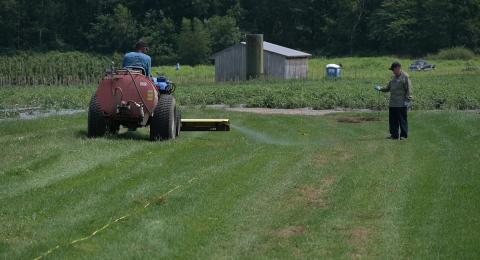As stated on all pesticide labels - the sprayer needs to be calibrated before you spray!
Proper Calibration
Proper calibration of boom sprayer equipment is the only way to ensure spray applications are effective, efficient, and economical. One of the most important reasons is to ensure you are not over-applying or under-applying a pesticide. Applying too much pesticide hurts your bottom line, may harm non-target plants or insects, and is illegal. Too little can lead to poor pest control. Poor spray coverage is the primary cause of reduced spray product performance.
Growers must frequently adjust sprayer outputs and vary application speeds throughout the growing season to account for variations in different crops or crop growth, the time of season and the purpose of the spray. Unfortunately, some growers often bypass these adjustments because sprayer calibration is considered difficult and time consuming. Sprayer calibration adjustments are worth the time and effort.
A sprayer should never be operated without first checking the calibration. Calibration enables the operator to:
- Determine the precise rate of material applied per acre.
- Ensure uniform application from all nozzle tips to ensure each of the nozzle tips are operating at the manufacturer's specification.
- Compensate for equipment changes, crop staging, and environmental conditions.
- Determine the change in delivery rate when old worn parts have been replaced.
- Compensate for changes in delivery when switching from one spray material or formulation to another. Chemical sprays or fertilizer solutions may show a 5 to 10% difference in output as compared to clear water.
Sprayer calibration is not complicated nor time consuming. Proper calibration is one of the most important steps in any integrated pest management program.
Calibrate boom sprayers:
- at the beginning of each season
- mid-way through each season as crops grow and fill in
- after changes to application equipment or settings (e.g., nozzles, operating pressure, pump, tractor, or tractor tires)
The 1/128th method of calibration works well for broadcast applications, such as herbicide application where the goal is uniform coverage over a given area.
This simple method for sprayer calibration requires very few calculations. It is based on spraying 1/128th of an acre per nozzle and simply collecting the spray released during the time it takes to travel over that given area. Since there are 128 fluid ounces in 1 gallon, the number of ounces collected equals the application rate in gallons per acre.
For boom sprayer broadcast applications, all spray tip nozzles will be spaced evenly along the length of the boom. However, potential pressure differences can occur between nozzles, making it important to measure output from each nozzle tip to identify differences.
To calibrate your sprayer, you will need a measuring tape, a stopwatch, and a graduated liquid measuring cup.
Before You Start
Prior to calibrating a boom sprayer, complete the following tasks:
- Triple rinse the tank and piping. Take special care to flush manifolds and nozzles.
- Be careful if pressure washing sprayers. Some say this forces water into sealed parts, like bearings. You can use push brooms and hoses to scrub them off. Pay special attention to cleaning both sides of the nozzles and around pumps and filters.
- Clean nozzles and record the orifice and whirl disc sizes. Do not use any metal object or your mouth when cleaning sprayer tips. Soft brushes and cans of compressed air work well.
- Check that the main pressure gauge is working properly.
- Ensure all hoses and fittings are sound.
- Flush out the line to the pressure gauge.
- Clean filters/strainer, including tank filters, suction filters, final filters and every screen behind nozzles.
- Make sure all valves, diaphragms, and O-rings are in good condition and working properly.
- Check that the agitation system is functioning properly.
- Check tire pressures on both the sprayer and tractor.
- Make sure the tachometer is working on the tractor.
- Fill sprayer halfway with clean water.
- Involve operators or mechanics who work with the sprayer/tractor combination with calibration.
- Have sprayer operator's manual on hand.
1/128th Method of Calibration of a Low-Pressure Boom Sprayer
Use the accompanying worksheet, Boom Sprayer Calibration Worksheet, - 1/128th Method to record your results.
- Measure the distance between nozzles in inches. For a boom sprayer that has nozzles placed 20” apart, measure off a distance of 204 feet on a field similar to that which you will spray (e.g., sod, disked, etc.).
- Fill the sprayer halfway with water. Then drive the correct distance shown above and note the exact time in seconds it takes to pass the end points. Make a return pass and check the time again. If the time differs by no more than 2 seconds, average the two times. Repeat if the time differs by 3 seconds or more. Note the engine RPM and gear that were used to make the passes.
- With the tractor in a stationary position, set the same engine RPM used in step 2.
- Set the application pressure (typically 30-40 psi for boom sprayers) that you normally use and spray water through the boom.
- Check whether the spray patterns from all the nozzles look uniform. If they don't, the tips should be removed and checked for wear or blockage. Do not use any metal object when cleaning sprayer tips. Use a soft brush and a can of compressed air.
- When all the nozzles appear to have a uniform delivery at the desired psi, place a container under the first nozzle and collect the spray output for the exact number of seconds noted in step 2 above. Record the number of ounces collected. Repeat this process for each nozzle.
- Calculate the average ounces collected per nozzle. If the output from any nozzle varies by more than 10% from the average, replace that nozzle. If the average output is 15% more than the output of a new nozzle (as indicated in the manufacturer's chart or discharge test), replace all the nozzles.
- The average ounces collected per nozzle for the exact number of seconds determined in step 2, equals one nozzle's rate of spray per acre in gallons. For example, if an average of 18 ounces are collected in the time noted in step 2 above, you are spraying 18 gallons per acre from each nozzle.
The correct distance for other nozzle spacings is as follows: (*340 feet/nozzle space (in feet) = distance)
| Nozzle Space | Travel Distance* | Nozzle Space | Travel Distance* |
| 8 inches | 510 feet | 28 inches | 146 feet |
| 10 inches | 408 feet | 30 inches | 136 feet |
| 12 inches | 340 feet | 32 inches | 128 feet |
| 16 inches | 256 feet | 36 inches | 113 feet |
| 18 inches | 227 feet | 40 inches | 102 feet |
| 20 inches | 204 feet | 42 inches | 97 feet |
| 22 inches | 185 feet | 46 inches | 89 feet |
| 24 inches | 170 feet | 48 inches | 85 feet |
Calibration Notes
Maintaining accurate records is essential to the calibration optimization process. Once you have adjusted your sprayer to the correct calibration, write down the settings (along with the date and time of testing) so that you can use the optimized settings in the future. This is especially helpful if your sprayer is repaired or modified. By having a record, you can compare your sprayer calibration calculations from one calibration to the next.
Additional Resources
• Boom Sprayer Calibration Worksheet - 1/128th Method
• Boom Sprayers - One-Minute Method of Calibration
• Boom Sprayers - How to Optimize Spray Distribution
Rociadores de barra - Método de calibración 1/128: un método rápido y sencillo | Extension (español)
About the Author
George Hamilton is a retired UNH Cooperative Extension Field Specialist in agriculture dealing with fruit and vegetable production. Fact sheet updated November 2023.
UNH EXTENSION'S FOOD AND AGRICULTURE PROGRAM
As a component of Extension's Food & Agriculture Program, Extension specialists provide educational resources, training programs, and direct technical assistance for private and commercial pesticide applicators.
Extension Services & Tools That Help NH Farmers Grow
Newsletters: Choose from our many newsletters for production agriculture
Receive Pest Text Alerts - Text UNHIPM to (866) 645-7010


